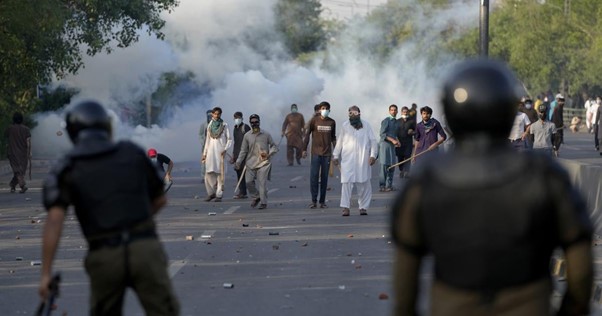Deep Defense – A Timeless Tactical Doctrine
Tue, 20 Sep 2022 | Reading Time: 4 minutes
‘Strategy without tactics is the slowest route to victory. Tactics without strategy is the noise before defeat’ – Sun Tzu.
As we are closely stepping foot into the silver jubilee timeline of the 21st century, the role of changing dynamics in every part of our lives has been apparent. One such major shift involves the role of fighting wars (formally known as warfare) which has witnessed its own evolution ranging right from conventional tactics to the asymmetrical engagements. Out of this collection, one lesser heard terminology is called Deep Defense or more likely what its largely known as ‘Defense In-Depth’ (DID).
Deep Defense defines a military strategy that focuses on delaying rather than preventing the advancement of an attacker, buying time and causing additional casualties by yielding space. Rather than defeating an attacker with a single, strong defensive line, defense in-depth relies on the tendency of an attack to lose momentum over time or as it covers a larger area. A defender can thus yield lightly defended territory in an effort to stress an attacker’s logistics or spread out a numerically superior attacking force. Once an attacker has lost momentum or is forced to spread out to pacify a large area, defensive counter-attacks can be mounted on the attacker’s weak points, with the goal being to cause attrition which drives the attacker back to its original starting position.
From this we can concur that its basic principles directs to minimize the amount of casualties faced via defending while maximizing the casualties suffered by the enemy during an attack. Going into the details, this process involves an elastic defense that would give up land to the enemy in exchange for retaining a defensive line. This line also explains it being known as ‘Elastic Defense’ where more strongly fortified defensive lines could be broken if given enough pressure, an elastic defense would have multiple lines of less fortified defenses each protecting the other, weakening the enemy over time rather than plainly holding back any attempt while advancing.
Speaking about its origination, the DID initially set its footmarks during the age of illustrious Roman Republics notably in the Battle of Cannae in 216 BC. As time progressed, this tactic was incorporated in many historical conflicts like the American War of Independence where the American forces were able to absorb the shocks of British charge subsequently resulting in several casualties which broke their cohesion. The Pacific War saw some major instances of the same inflicting heavy casualties on the US forces by the Japanese soldiers.
However the major significance of this tactical display came during World War I and II respectively. During the first world war, the German Army first adopted this strategy in 1917 calling for the creation of three defensive zones namely the ‘Outpost’ zone, the ‘Battle’ zone, and the ‘Rearward’ zone. By creation of multiple trench lines the German troops would use their reserves that had been saved from a concentrated defensive line and launch prompt counterattacks so that the defensive line would ‘bounce’ back to its original point. This resulted in successful retention of their grounds with minimum casualties. Subsequently such styles of formations were improvised by other forces most notably the Japanese Army during the Second World War when their commanders realized that any attempt to simply stop American advances on islands at the beachhead would be foolish and a waste of resources as it would be impossible. What instead should be done is create many different defensive positions, each protecting the other and attempt to “bleed” the enemy until they cannot continue to expend troops and material.
Notably, these defensive positions were often well hidden and maintained sound fire discipline so as only to use up ammunition when many enemy casualties could be ensured. This made it exceedingly difficult for Allied troops to dislodge Japanese positions with artillery or air strikes as they largely only became visible while firing. One of the most successful modern examples of DID would be one during the Battle of Kursk. During the battle, the Red Army (USSR) deliberately drew the Germans into an attritional battle in multiple, well-prepared defensive lines, before launching massive counter-attacks on either side of the 9th Army in the north and the 4th Panzer Army in the south. The initial German offensive never fully penetrated the Red Army lines.
By contrast, the subsequent Red Army counter-offensive pushed the front line hundreds of miles westwards. Furthermore the North Atlantic Treaty Organization (NATO) had also shown glimpses of putting such tactics into use during the Cold War era. The Fulda Gap represented the shortest route (through the cities of either Fulda or Giessen) from the border between East Germany and West Germany to the Rhine River. Throughout the Cold War, the NATO and Warsaw Pact military forces remained heavily concentrated in the area. So one can observe the importance of DID through the lens of multiple examples highlighted above.
However every military strategy comes with their own set of pros and cons. A well-planned DID strategy will deploy forces in mutually supportive positions and in appropriate roles. For example, poorly trained troops may be deployed in static defenses at the front line, whereas better trained and equipped troops form a mobile reserve. Successive layers of defense may use different technologies against various targets. A ‘Dragon Teeth’ like fortification might present a challenge for the tanks but can easily be circumvented by the infantry. DID may allow a defender to maximize the defensive possibilities of natural terrain and other advantages. The shortcomings of DID are that it may be unacceptable for a defender to plan to give ground to an attacker. This may be because vital military or economic resources are close to the front line or because yielding to an enemy is unacceptable for any political or cultural reason. Although today, DID has largely been abandoned as a military tactic, micro versions of the same can still be visible in the upcoming future of warfare.
Disclaimer
The opinions expressed in this article are the author’s own and do not reflect the views of Chanakya Forum. All information provided in this article including timeliness, completeness, accuracy, suitability or validity of information referenced therein, is the sole responsibility of the author. www.chanakyaforum.com does not assume any responsibility for the same.
Chanakya Forum is now on . Click here to join our channel (@ChanakyaForum) and stay updated with the latest headlines and articles.
Important
We work round the clock to bring you the finest articles and updates from around the world. There is a team that works tirelessly to ensure that you have a seamless reading experience. But all this costs money. Please support us so that we keep doing what we do best. Happy Reading
Support Us




















POST COMMENTS (3)
Kalidan Singh
Rakesh
manan desai